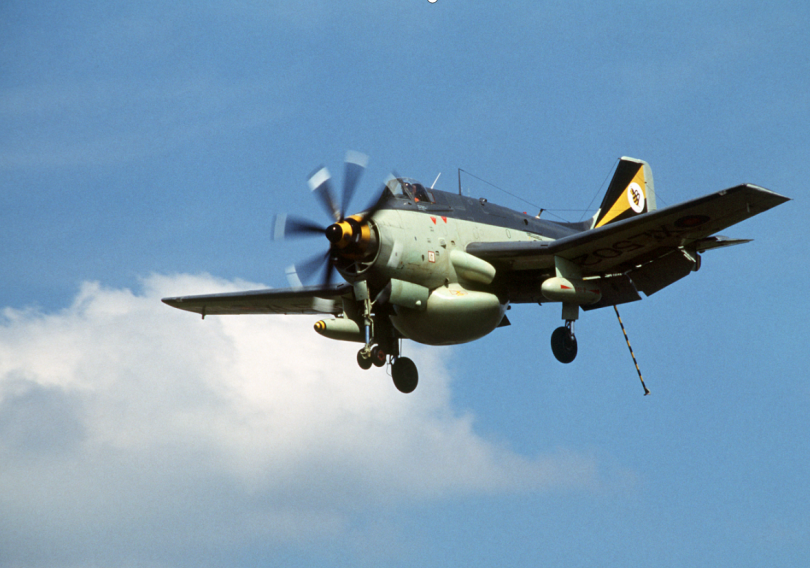When queen Elizabeth deployed F-35B fighter jets, Britain became the second country in the world to deploy fifth-generation fighters on an aircraft carrier, ending the carrier's history of not having carrier-based fighters available. In order to give full play to the combat capabilities of the aircraft carrier, the United Kingdom has also developed an early warning helicopter using the "Crow's Nest" early warning system, but compared with the fixed-wing carrier-based early warning aircraft, its performance is only enough, and the British aircraft carrier formation is still unable to solve the "myopia" problem.
Don't look at the British now has no real sense of the use of carrier-based early warning aircraft, in fact, the United Kingdom as a veteran aircraft carrier power, although not the first to develop a successful carrier-based early warning aircraft of the country, but also one of the earliest countries equipped with carrier-based early warning aircraft, as of 1978, the British Navy's last large aircraft carrier "Royal Ark" before the retirement, the British Navy has a regular carrier-based early warning aircraft to use, "Gannet" is its last type of carrier-based early warning aircraft, the aircraft has even enjoyed the title of the world's ugliest aircraft.

"Gannet" is a shipboard anti-submarine aircraft and early warning aircraft developed by the British Faire Aircraft Company for the British Navy after World War II, which is mainly used for long-range anti-submarine operations of aircraft carrier combat formations, and its development type can perform early warning at sea, air command and electronic countermeasures tasks.
In 1951, the first 100 Gannets ordered by the British Navy began to be tested aboard the aircraft carriers Ark Royal and Eagle in November 1953. In March 1954, the "Gannet" was officially commissioned, and its initial "Gannet" AS.1 was first assigned to the 703rd Flying Squadron. A total of 181 "Gannets" 5.1 were built. A Gannet 2 variant was also specially built to train pilots to operate unique twin-shaft engines and how to use anti-submarine weapons. The cockpit in the middle of the T.2 trainer is the flight instructor's seat, which is equipped with a complete set of backup flight control equipment and a forward-looking periscope. The radar at the rear of the fuselage was cancelled, but the rear cockpit of the radar operator was retained. The first T.2 first flew on August 16, 1954, with a total production of 38.
Since 1956, the "Gannet" began to use a 2265 kW improved Mark101 twin-shaft turboprop engine, the newly produced aircraft was named "Gannet" AS.4, first flew in 1956, and the corresponding coach "Gannet" 5 also flew in 1957. A total of 75 AS.4s were produced, eight T.5s were built, and some of the existing AS.1 and T.2 were upgraded to AS.4 and TS.
Some "gannets" are also offered to countries outside the UK. The Royal Australian Navy ordered 40 aircraft in late 1952 and delivered them from 1955 onwards, when in fact only 36 were delivered, including 33 AS.1s and 3 T.2s. These "Gannets" are mainly equipped with the aircraft carrier "Melbourne" and coastal anti-submarine forces. The former West German Naval Aviation received 15 AS.4s and l T.5s.
The "Gannets" supplied to Australia and West Germany are all newly built aircraft, and their quantities are included in the total production figures. Indonesia also received 16 AS.4s and 2 T.5s, but these aircraft were improved on the Royal Navy's AS.1 and T.2 respectively.
At that time, the early air warning of the British carrier-based aviation was mainly carried out by the American Douglas AD-4W "Sky Striker", and in order to replace the "Sky Striker", the British Navy signed a contract with Fairleigh Company, requiring the latter to convert the "Gannet" into an early airborne early warning aircraft. The company developed the "Gannet" AEW.3, which first flew in August 1958. Although the company was initially prepared to make "minimal changes," the entire fuselage was almost redesigned to solve the various problems encountered, with the pilot cockpit being moved forward and two radar operator seats in the rear fuselage, with radar operators coming in and out through side doors. The exhaust pipes of the twin-shaft turboprop engine are moved up to the front of the wing to provide more space for radar operators. A large radome was installed under the fuselage, including an AN/APS-20 radar removed from the Sky Striker, and the vertical tail was raised accordingly to compensate for the change in aerodynamic characteristics brought about by the addition of the early warning radar.
The "Gannet" AEW.3 was powered by a 2,890 kW Mk.102 twin-shaft turboprop engine, which had been discontinued in 1961 and had been built in total, by which time Fairleigh had been incorporated into Westland. The last AEW.3 rolled off the production line in 1962, and it was also the last fixed-wing aircraft the company built. Together with the prototypes, the total production of each gannet type was 349.